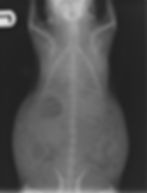My guinea pig is breathing heavy - let's talk about heart disease.
- The Guinea Pig Vet
- Apr 1, 2021
- 2 min read
Updated: Nov 23, 2021
If you notice that your guinea pigs is breathing heavy or quickly, it is best to take them to a vet as soon as possible. A common clinical sign we see during appointments is increased respiratory rate or effort.
There can be several causes for this, the most common of which include respiratory disease and heart disease. In this blog we are going to talk about heart disease.
Heart disease occurs relatively frequently in guinea pigs, it can be due to problems with the heart muscle, the heart valves or the pericardium (fibrous sac that surrounds the heart). Once significant clinical signs are apparent we say that the heart disease has progressed to heart failure.
Signs of heart failure to look out for include:
Increased respiratory rate or effort (notable, bellowing movements can be seen)
Respiratory noise, crackling, wheezing or hooting
Lethargy, reduced movement
Cyanotic (blue) mucous membranes (gums).
Cold extremities (eg feet, predisposing to bumble foot).
Reduced appetite and weight loss, as the guinea pig may have to choose between breathing and eating.
Fluid build up under the skin (subcutaneous eodema), sometimes mistaken as a diffuse mass.
Fluid build up in the abdomen (ascites), seen as an enlarged abdomen.
Heart disease can be diagnosed by your vet by clinical exam. A vet will:
Note the above signs of heart failure
Listen to the heart and lungs with a stethoscope (thoracic auscultation). The heart rate in a guinea pig is often very high, this makes it difficult to pick up subtle changes in heart sounds or rhythm, but your vet may be able to hear a murmur or arrhythmia. In addition, there may be crackles over the lung fields.
Chest x-rays are useful to determine heart size and external shape, fluid build up (congestion) and lung patterns
Ultrasound of the heart (echo) gives information on the structure of the heart as well as the movement of the heart
This lateral x-ray shows reduced air filled lungs, indicating fluid build up in the chest cavity (pleural effusion).

In this dorsoventral x-ray, you should be able to see black/dark air filled lungs. What the x-ray shows is a complete loss of detail in the chest cavity (no dark air filled lungs). This indicates fluid build up in the chest cavity.

Treatment: There are several treatment options for heart failure in guinea pigs, however, ultimately the condition will be life limiting. The treatment aims to alleviate the clinical signs and improve the quality of life but will not cure the condition and will need to be given lifelong after diagnosis.
Treatments can include:
Diuretics, these remove fluid from the body to relieve congestion and can include frusemide and spirinolcatone.
Pimobendan, a drug that helps the heart to pump more efficiently by increasing heart rate and effort.
Benazepril, this drug is known as an ACH inhibitor and helps by reducing vasoconstriction (narrowing of the vessels) which improves the efficiency of the heart.
If you notice signs of possible heart failure in your guinea it is important to see a vet, for diagnosis and possible treatment.